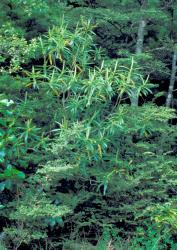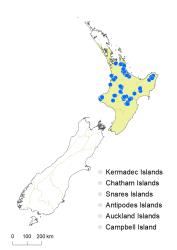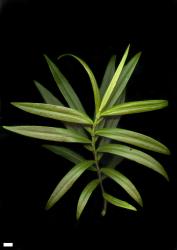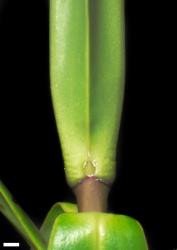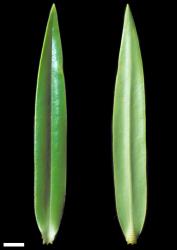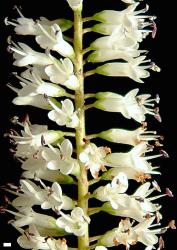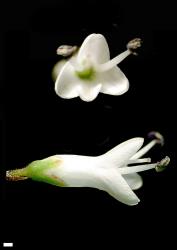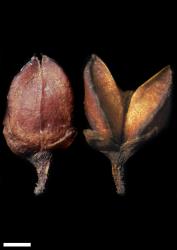- ≡ Hebe corriganii Carse, Trans. & Proc. New Zealand Inst. 60: 573 (1930)
Openly branched bushy shrub to 2.5 m tall. Stems erect, glabrous or eglandular-puberulent; hairs usually bifarious or occasionally uniform. Leaf bud distinct, its outer leaves appressed at margins until fully grown; sinus small, squarish, rounded, elliptic or oblong. Leaves opposite-decussate, erecto-patent to spreading or reflexed; lamina coriaceous, linear-lanceolate, 70–145 mm long, 7–20 mm wide, glossy or dull, dark green or green above, green or pale green beneath; midrib evident, secondary veins sometimes evident in fresh leaves; surfaces with eglandular hairs along midrib above; margin ciliate to ciliolate, entire or with distant minute teeth; apex sub-acute to acute; base abruptly cuneate; petiole 2.5–3.2 mm long. Inflorescence a lateral raceme, 80–145 mm long; flowers crowded, 100–120 per inflorescence, all bisexual; bracts alternate to loosely whorled, lanceolate, ≤ pedicels; pedicels erecto-patent, 1.4–4.0 mm long, eglandular-hairy all around. Calyx lobes 4, usually obtuse, rarely acute to acuminate, 1.8–2.1 mm long, sub-equal, mixed glandular- and eglandular-ciliolate. Corolla 4–6 mm diameter; tube white, 3.5–5.0 mm long, > calyx, eglandular-hairy inside; lobes 4, white or tinged pale purple, sub-erect to spreading, sub-equal, ovate, 2.5–3.5 mm long, rounded; nectar guides absent. Stamen filaments white, 4.5–5.0 mm long; anthers pink. Style glabrous, 4.5–9.0 mm long. Capsules latiseptate, sub-acute to acute, glabrous, 3.6–7.0 mm long, 2.3–4.0 mm at widest point. Seeds ellipsoid to discoid, flattened, smooth, pale brown, 1.3–2.2 mm long.
Veronica corriganii is most similar to V. macrocarpa, which it replaces geographically from western Bay of Plenty eastward and southward. V. macrocarpa plants differ in not having a leaf bud sinus, shorter petioles 0–2 mm long, fewer flowers (13–85) per inflorescence, and stamen filaments 5.5–13 mm long.
V. corriganii can also be difficult to distinguish from V. stricta, especially the sub-alpine tetraploid forms var. egmontiana and var. lata. However, V. stricta plants consistently lack a sinus in the vegetative bud, have smaller flowers with narrower, usually acute to acuminate calyx lobes, more slender corolla tubes, and narrower corolla lobes than V. corriganii, and smaller capsules (1.3–4.0 × 2.0–3.3 mm) and seeds (0.9–1.2 mm long).
North Island: Auckland (south of Hunua Ranges), Volcanic Plateau, Gisborne, Taranaki, Southern North Island (Ruahine Range and Kaweka Range).
Often in forest or scrub from coastal to sub-alpine altitudes. Recorded elevations range from 46 to 1433 m.
Flowers: July–March; fruits: August–April, persisting all year.
2n = 80 (see Bayly & Kellow 2006, as Hebe corriganii).
Veronica corriganii is classified in V. subg. Pseudoveronica sect. Hebe and the informal group “Apertae” (large-leaved) (Albach & Meudt 2010; Bayly & Kellow 2006).
The Māori names koromiko, kōkōmuka, and variants, applied to V. stricta and V. salicifolia, might be applied also to similar large-leaved hebes, such as V. corriganii.



